The wind phone
The wind phone is an unconnected telephone booth in otshuchi, iwate perfecture, Japan, where visitors can hold one-way conversations with deceased loved ones. Initially created by garden designer Itaru Sasaki in 2010 to help him cope with his cousin's death, it was opened to the public in the following year after the 2011 Tohoku earthquake and tsunami killed over 15,000 people in the Tohoku region. The wind phone has since received over 30,000 visitors.
Sasaki’s home, and the Wind Telephone, are on the outskirts of Otsuchi, a small coastal city in northern Japan’s Tohoku region. On March 11, 2011, while Sasaki was putting the finishing touches on his project, a magnitude 9.1 earthquake in the ocean off the Tohoku coast triggered gigantic tsunamis. Otsuchi was devastated by 30-foot waves; a tenth of its 16,000 inhabitants were confirmed dead or never accounted for.
The Wind Telephone, created to ease one man’s grief, became a place of solace for thousands as word of its existence, and its purpose, spread via local media. “It is believed,” says the Atlas Obscura website, “that 10,000 visitors journeyed to this hilltop outside Otsuchi within three years of the disaster.”
Survivors of the tsunami have been joined in this pilgrimage by people who’ve lost loved ones in other ways, including suicide and accidents. In 2016, the radio program produced a podcast that included recordings of some of the conversations on the Wind Telephone. “There’s laughter,” writes Sherilyn Siy on the website Tokyo Creative. “There are sniffles of tears being held back. Through the most ordinary of conversations, the powerful undercurrents of emotions are clearly discernible: the regret, pain of loss, despair, guilt, frustration, search for strength, hope, and the will to carry on without the loved one.”

Comments
Post a Comment